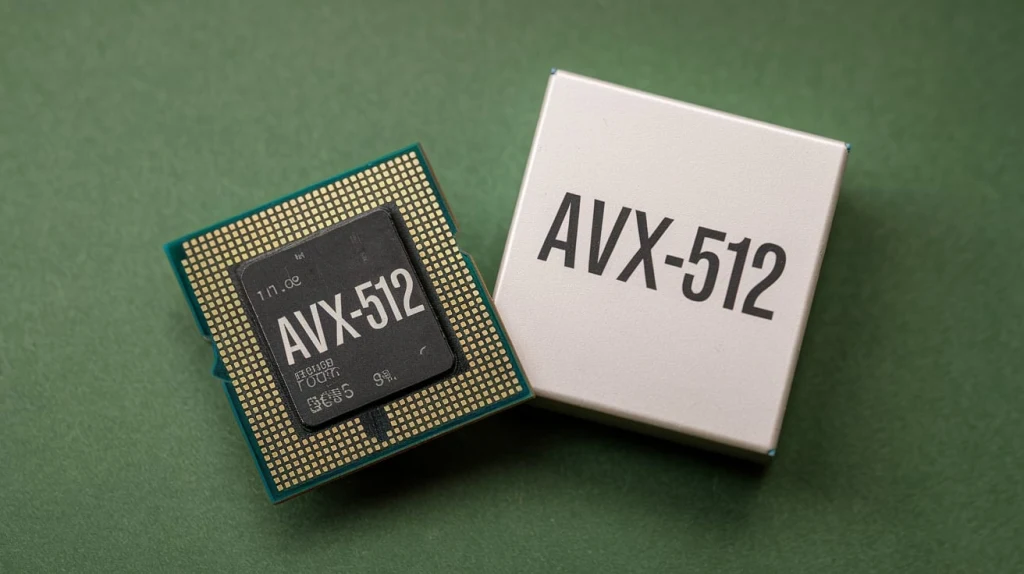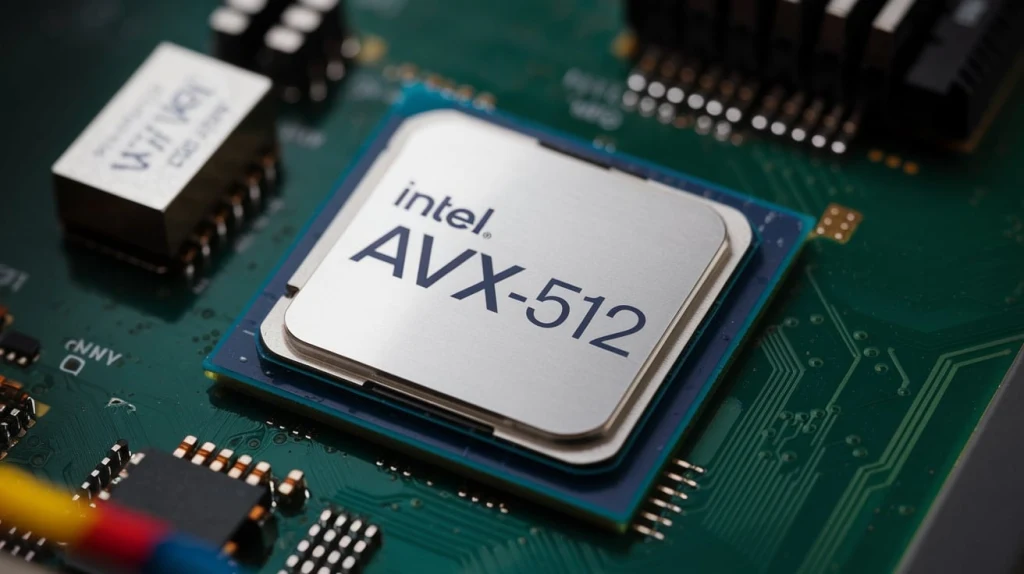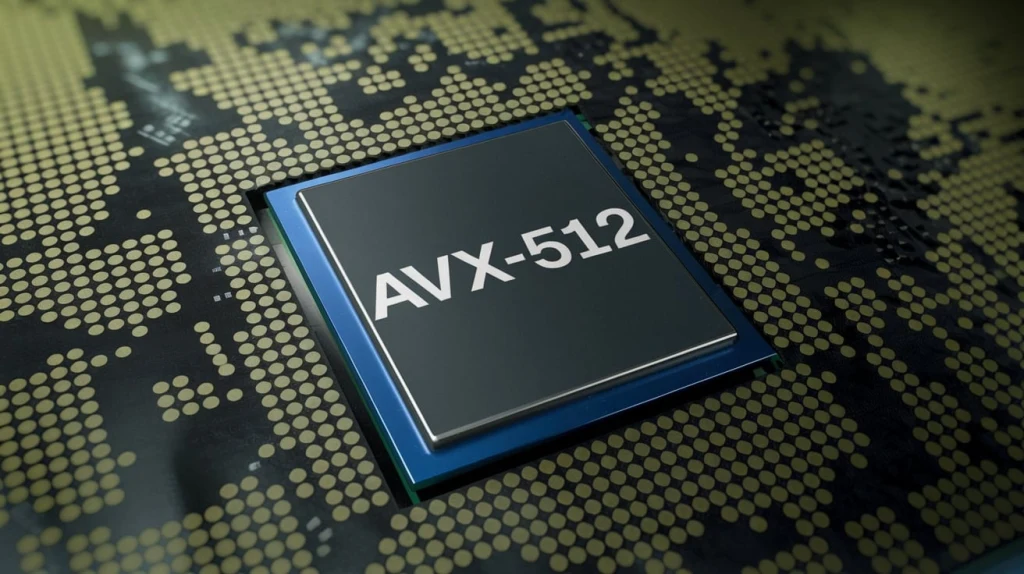What is Intel’s AVX-512 and What Are Its Benefits and Applications?

As modern workloads grow in complexity, ranging from deep learning in artificial intelligence to high-performance analytics, processing power must evolve to keep up. Intel® AVX-512 is the most powerful extension of the x86 instruction set, designed to seamlessly handle demanding computational tasks.
At ServerMania, we provide an excellent environment to take full advantage of AVX 512 instructions, by providing servers, designed for high-demand workloads. So, we’ve decided to craft this quick guide and explore what exactly is AVX 512, providing some clarity on its benefits, applications, and challenges.
Let’s learn what exactly is AVX-512 and why it’s so important for performance-driven workloads in 2025.
What is AVX-512?
Intel® Advanced Vector Extensions 512 (Intel® AVX-512) is an essential workload-specific accelerator that is included in all Intel® Xeon® scalable processors. This is an integrated feature that supports the most advanced workloads such as heavy analytics, AI, HPC, and networking that requires performance.
While handling demanding tasks is still possible without it, utilizing the AVX-512 infrastructure can avoid extreme costs and scalability issues. The Intel® AVX 512 provides a built-in instruction set for AI, scientific simulations, data analytics, and other heavy tasks that require vector-based computation.
AVX 512 is an essential part of the Intel® AI Engines and Intel® HPC Engines available in the latest Intel® Xeon® processors. Some of them include:
- Intel Xeon Scalable – Granite Rapids CPU
- Intel Xeon Scalable – Skylake-SP CPU
- Intel Xeon Scalable – Cascade Lake-SP CPU
- Intel Xeon Scalable – Ice Lake-SP CPU
In short, AVX-512 is designed to take full advantage of Intel’s hybrid architecture, where P-cores handle demanding computational tasks, while E-cores focus on background processes and energy efficiency.
The powerful AVX 512 instructions allow you to get more from your CPU, so you can fuel demanding workloads with optimal efficiency. The simplicity of built-in accelerators when compared to discrete accelerators is an excellent way to reduce deployment time, operational cost and simplify integration.

How AVX-512 Works?
Intel AVX-512 utilizes extended mask registers, making it efficient for vector processing, which is an essential part of the most advanced computational tasks. With the 512-bit vector instructions, AVX-512 can execute the most demanding operations without the need for specialized hardware for the server.
The AVX 512 register file supports 8 x 64-bit and 16 x 32-bit integers along with 4 single-precision and 32 double-precision floating-point arithmetic.
These floating point calculations enable great parallelism, which can handle great complexity in fewer clock cycles, turning the AVX 512 Xeon processors into performance giants.
In addition, Intel® AVX 512 instructions provide up to 2 x 512-bit fused-multiply add (FMA) units, which doubles the width of the vector calculations.
What is Advanced Vector Extensions?
Advanced Vector Extensions (AVX), also known as Gesher New Instructions,are SIMD extensions to the same architecture of the x86 instruction set. AVX2, also known as Haswell New Instructions is the first accelerator to expand most integer commands to 256 bits, shipped in 2013.
AVX 512 leverages the same code and expands AVX to 512-bit, which is first supported by Intel® with their Knights Landing co-processors, shipped in 2016. Later, in 2017, AVX 512 was first introduced for conventional uses with the Skylake server and HEDT processors.

What Are The Benefits of Intel® AVX-512?
AVX 512 does not only boost performance but the advanced access and capabilities stretch into different benefits that we’re about to unwrap. Some of them include cryptography, cybersecurity, atomic simulations, and artificial intelligence, so let’s take an in-depth look at some specific sectors.
Workload-Specific Tasks:
The expanded vector register to 512 bits, doubling the data width when compared with AVX2, enables simultaneous processing of more data elements.
The floating point numbers process enhancement provides performance gains in various tasks such as scientific simulations, artificial intelligence, cryptography, cybersecurity, medical imaging, and more.
The increased register count from 16 to 32, minimizes the latency and can accelerate performance in workload-specific tasks that require parallel processing, typically found in server-hosting environments.
Consumption Efficiency:
Even though intel processors with AVX-512 lead to a higher power consumption due to the nature of the operation, the number of calculations per clock cycle eliminates the need for additional hardware. Well, looking at this objectively, specific workloads not only benefit from lower power consumption but also take advantage of operation at full speed.
This is especially helpful with colocation services, and data centers where less power means lower cost. Some examples include scientific computing clusters, AI model training farms, cloud-based financial analytics, and large-scale multimedia rendering farms. These environments demand high computational throughput, and AVX-512 enables them to achieve maximum performance without additional hardware.
App & Software Support:
The Intel® AVX 512 is also beneficial for many industry-leading and intensive AI frameworks such as PyTorch, ONNX, and TensorFlow by accelerating deep learning workloads. Another example would be video encoding with tools like x265, where AVX-512 dramatically enhances processing and efficiency.
In addition, the AVX 512 instruction set comes with Galois Field New Instructions (GFNI), which enhance cryptographic performance, enabling faster encryption for operating systems and software.
The Main Applications of Intel® AVX-512:
Intel® AVX-512 instruction set and its floating point play a key role and find application in many intensive tasks and mixed workloads. The powerful processing capabilities not only improve performance in various tasks and workloads but also minimize latency by enabling simultaneous execution of multiple operations.
Let’s take a look at the main real-world AVX 512 use cases:
AVX-512 in Machine Learning
AI and machine learning involve advanced mathematical computations, vectorized operations, matrix multiplications, and convolutions. With the AVX 512’s wide vector extension, processing of multiple data points by AI is now possible, as well as improved parallelism. In addition, the number of CPU runs per execution is cut in half, which can greatly accelerate the performance.
The dot-product computations and low-level optimizations such as fused multiply-add (FMA), help speed up both training and inference processes. This is especially helpful for enhancing performance in deep learning frameworks like TensorFlow, PyTorch, and ONNX Runtime.
In addition, AVX 512 reduces the need for additional components, which makes AI workloads possible in cloud-hosting environments for enterprises. Hence, with some workloads, AVX 512 eliminates the need for GPU server hosting solutions, which significantly reduces expenses.
AVX-512 in Financial Modeling
High-speed numerical computations are at the core of financial modeling, requiring processors that can handle intensive mathematical operations. AVX 512 SIMD instructions enhance financial analytics by reducing the time required for market simulation and risk assessment.
For instance, a popular financial modeling application of AVX 512 is the Monte Carlo Simulation, which is a model used to predict a variety of outcomes and probabilities. These simulations run millions of probabilistic calculations, and the AVX 512 instructions set in unmetered servers can handle it easily.
Another example of AVX 512 application in financial modeling would be algorithmic trading, nowadays adopted by many trading platforms across the web. With the rapid data compression and analytics, with AVX 512 instructions, algorithms can now make split-second trading decisions, for maximizing profits.
AVX-512 in Data Centers
The main application of AVX 512 in data centers would be in high-performance computing (HPC) tasks, for optimizing lag and power consumption. Nowadays, data centers must handle vast amounts of data quickly and efficiently, some of which involve system analytics, security operations, and AI inferencing.
For example, the SIMD instruction set not only boosts the performance of the cloud services but also enhances the virtualization environment. The AVX 512 instructions set is efficient in data compression, decompression, and encryption, allowing modern data centers to handle more work with fewer servers.
In short, these efficiency cores can provide more task execution per watt, leading to a noticeable price reduction, which in turn, lowers the utilization. Hence, lower utilization and fewer machine components lead to less cooling requirements, space, and consumption, decreasing the overall infrastructure cost.
AVX-512 in Scientific Research
Intel® processors advanced vector extensions, find another frequent application in scientific research by accelerating tasks such as physical simulations and weather modeling. The wider vector units and doubled general-purpose registers, reduce the simulation times and improve the model’s accuracy.
This not only delivers accelerated performance with atomic simulations but also helps researchers dig deep into complex biological systems to develop better drugs and treatments. To wrap this up, we can say that the main and real applications of this instruction set translate into reduced computational time.
Challenges and Limitations of AVX-512 CPUs:
While AVX 512 advanced capabilities can be extremely helpful in certain software applications, there are a few well-known challenges and limitations. To name a few, let’s start with…
- Lower Cores Clock Speed: Many CPUs are forced to reduce their clock speeds to cope with the heat and electrical consumption, so they can execute AVX 512 instructions effectively.
- Limited Software Support: While many specific workloads like HPC, AI, and applications with parallelism benefit from the instruction set, many general software tasks see no improvements.
- Compatibility Challenges: Some Intel® processors are forced to disable AVX 512 instructions entirely, while AMD integration is not native, causing additional compatibility challenges.
- Higher Production Cost: The increased complexity of integrating AVX-512 vector instructions into CPUs, potentially increases the production cost and limits its use in small business servers.
The speed, heat generation, production cost, and compatibility are only a part of all the challenges that manufacturers face. However, as recent processors’ architecture continues to evolve and adapt AVX 512 better and better, we can expect a significant reduction in production price, deployment, and challenges.
Do You Need Intel for AVX-512?
While Intel® CPUs are the first to introduce this modern instruction set, you don’t necessarily need Intel, since AMD also supports AVX-512, although with some differences in implementation and focus.
AVX-512 Vs AMD – Let’s Compare Instructions
While Intel® introduced and popularized access to AVX 512 and all these new features, AMD has used a slightly different mode for handling vector processing. AMD’s Zen 4 architecture supports a subnet of AVX 512, where a single instruction is split into two 256-bit operations, instead of 512-bits per cycle.
Hence, this reduces the electrical consumption and improves vector processing performance but not as much as Intel’s full-width execution.
AMD has been strict in employing AVX 512 support, prioritizing scalability and electrical consumption, and ensuring the acceleration doesn’t affect the clock speed. This is a balanced implementation, that caters to server owners and providers, even though Intel delivers the most advanced AVX 512 support.
Quick Note: To learn more about both manufacturers we recommend checking our Intel vs AMD guide.
The Future of AVX 512: Evolution or Painful Death?
The exact future of this technology remains uncertain. The rise of hybrid architecture with P-cores and E-cores evolves, which further complicates the adoption since efficiency cores lack AVX-512 support. Some experts speculate that AVX is going downhill, while others remain optimistic that it will thrive in server and enterprise environments.
Despite all the challenges, the AVX 512 performance acceleration continues to play a vital role in many data centers, AI training workloads, and scientific simulations in 2025.
If one thing is for certain, is that the next few years will determine its fate!

AVX-512 High-Performance Computing at ServerMania
With cutting-edge processors and strategically located global data centers, ServerMania empowers your workloads to fully leverage the power of advanced vector extensions like AVX-512. Get started today and experience unmatched computational performance.
If you have a question or inquiry, feel free to request a quote–we’re here to help!
Was this page helpful?

